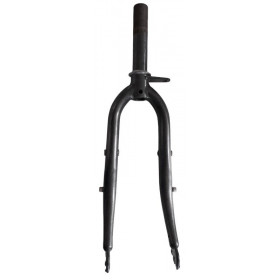-
 New productRigid fork for recumbent bike 20 inches
New productRigid fork for recumbent bike 20 inches- €59.99
Showing 1-1 of 1 item(s)
A recumbent bike fork performs similar functions to a traditional bicycle fork, but it is specifically designed for use on recumbent bikes, also called recumbent bikes. Here is a description of its function and characteristics:
1. Function:
- The fork of a recumbent bike fulfills several important functions:
- Support for the front wheel :
The fork supports the front wheel of the recumbent bike and ensures its attachment to the front part of the frame, providing a strong and secure connection between the wheel and the rest of the bike.
- Directional stability:
The fork helps maintain the bike's steering, ensuring a stable and predictable ride during turns and straights.
- Shock absorption:
The fork absorbs vibrations and shocks coming from the road, providing a more comfortable and controllable ride for the rider.
- Compatibility with brakes:
The fork is designed to be compatible with the bicycle's braking systems, ensuring effective and safe braking when needed.
2. Features:
- Specific geometry:
Recumbent bike forks usually have a specific geometry suited to the particular design of the recumbent bike. They can be tilted slightly rearward to accommodate the rider's prone position and provide stable, responsive steering.
- Construction materials :
Recumbent bike forks are often made from lightweight, stiff materials such as aluminum, carbon, or high-quality steel. These materials provide both excellent rigidity for efficient power transmission and a reduction in the overall weight of the bike for optimal handling.
- Compatibility with management:
The fork must be compatible with the bicycle's steering system, ensuring precise fit and smooth operation when rotating the steering.
- Setting options:
Some recumbent bike forks offer tuning options to adjust spring preload, compression and rebound, allowing the rider to customize the fork's performance based on their preferences and road conditions.
- Compatibility with accessories:
Some forks can be equipped with attachment points for accessories such as mudguards, bottle cages or lights, providing additional versatility to meet the rider's specific needs for comfort and convenience.
In summary, the fork of a recumbent bike is an essential component that supports the front wheel, provides stable and responsive steering, absorbs road shock and provides effective braking. Its main features include specific geometry, lightweight and rigid construction materials, steering compatibility, adjustment options and accessory compatibility. These features are optimized to provide a comfortable, controllable and safe ride on a recumbent bike.
